"Moni's Story"
Sezin Romi
March 17, 2023
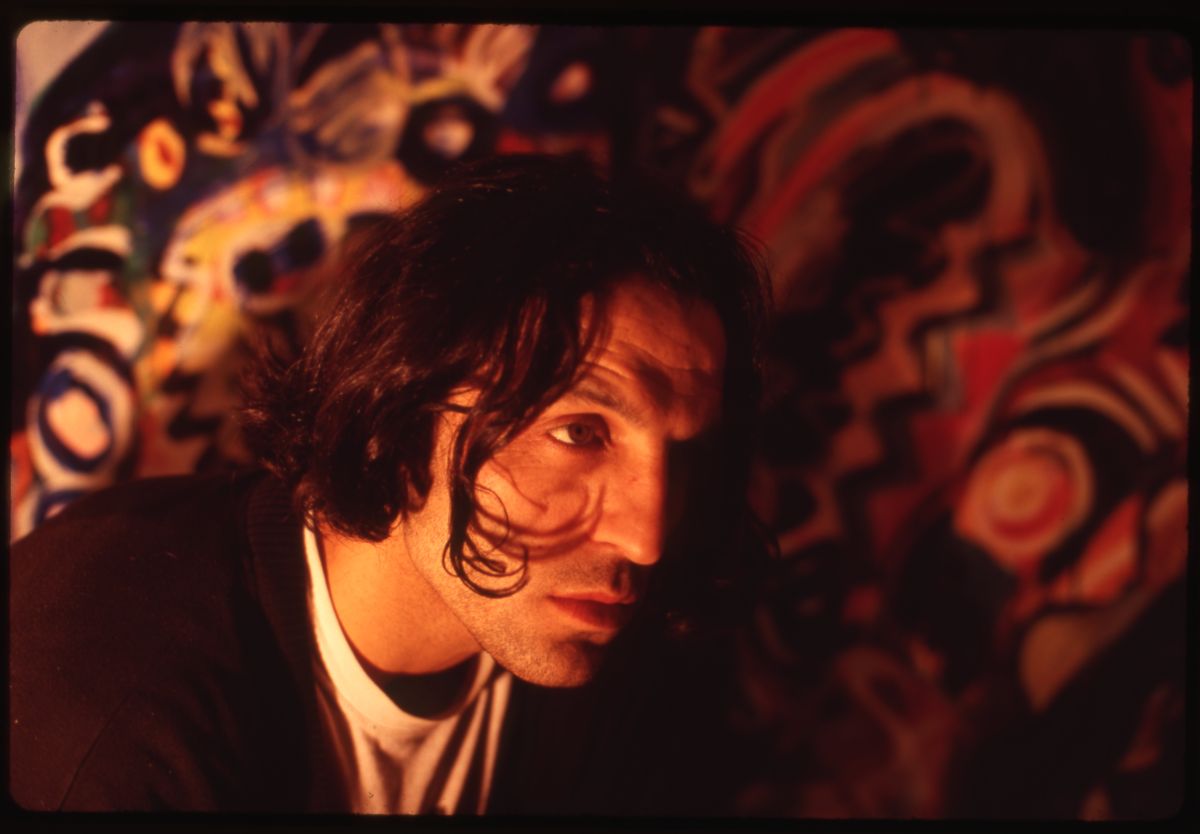
Moni Salim Özgilik, New York, 1994
Salt Research, Moni Salim Özgilik Archive
Salt Research, Moni Salim Özgilik Archive
The paths of Salt and Moni Salim Özgilik intersected during the digitization and cataloging of his archive in 2019. Bringing together documents related to the artist’s production from the end of the 1980s to the mid-1990s, the archive was made accessible online at Salt Research in 2020. A selection of works from his archive was presented in the exhibition The 90s Onstage, which focused on performance-driven productions in Turkey. This text was written while preparing for the conversation with the artist realized at Salt Beyoğlu on January 21, 2023, to provide a chronological perspective on Moni’s recorded and archived works from his student years in Ankara until his move to New York in 1992.
Performance and happening became a common form of expression in the second half of the 1980s in Turkey, especially among young artists. One of the pioneers of these emerging trends in Ankara, Moni produced provocative works that overflowed into public spaces and demanded participation. He quit the Geology Engineering Department at Hacettepe University in 1985 and continued his training in the Painting Department of the same university. Hacettepe University’s campus in Beytepe became a center for his production during his years as a student, from 1986 to 1990. The campus, which inspired numerous works by the artist, hosted murals, interventions, and installations that he made with found objects.
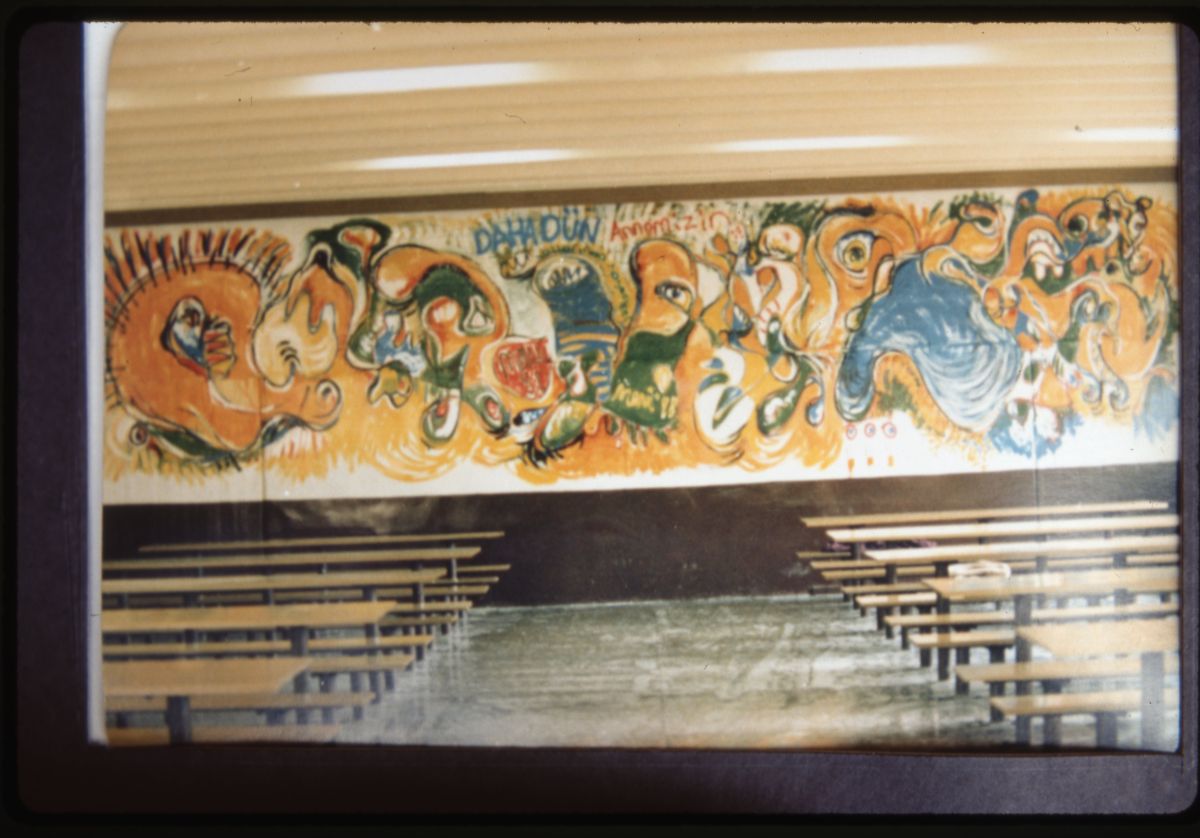
In his autobiography1, the artist notes that he had begun to focus on “discarded objects, thoughts on the side, concepts that remain in the books.” In his installation Kaos [Chaos] from 1987, presented on the roof of a building, he brought together discarded materials such as egg cartons and disposable cups. The next year, he produced Atık Direnç [Wasted Resistance] (1988) by constructing cardboard box walls, obstacles, and passages, including passersby with this intervention accompanied by music.
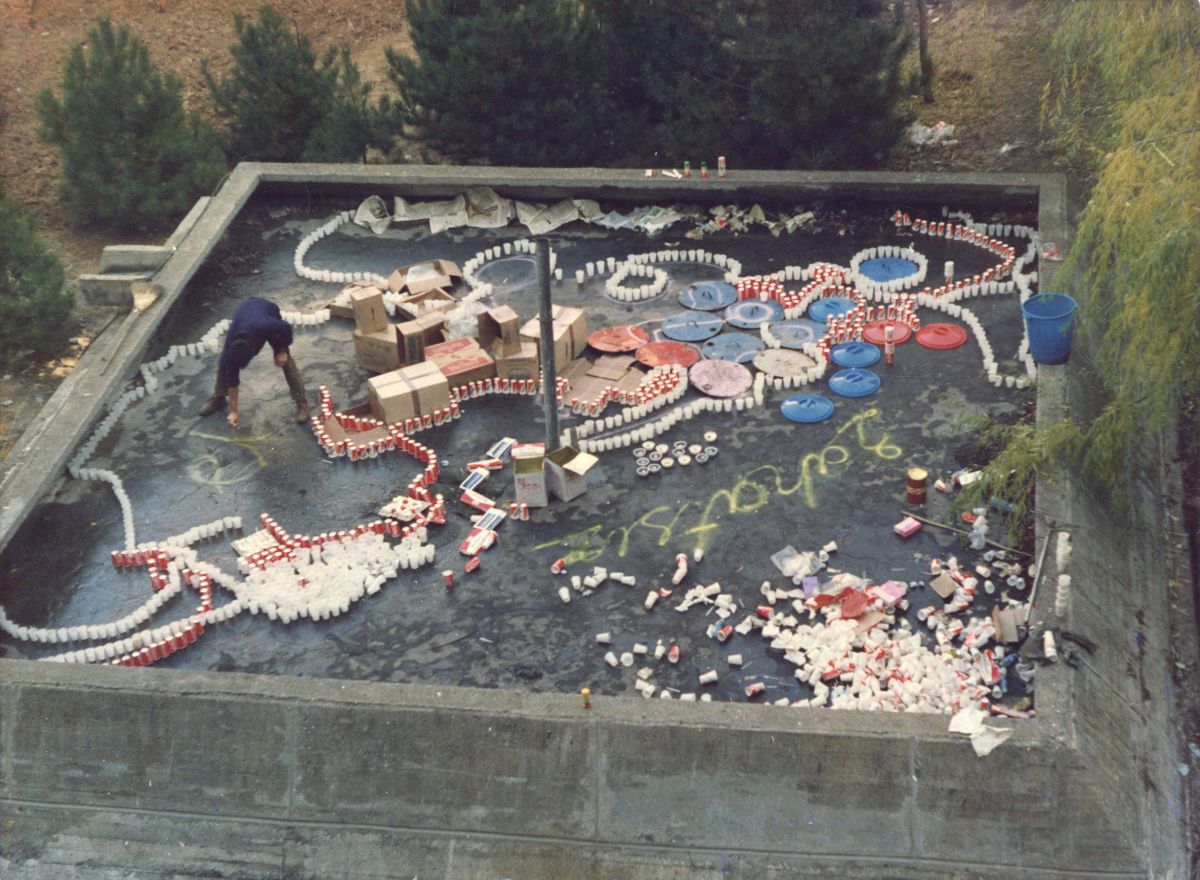

The 1980 coup d’état still influenced social and political life as the self-censorship of the press was ongoing, while the artist was studying at Hacettepe. Moni presented the work Kültür Ağacı [Cultivated Tree] (1988) as a reaction to art news not finding a place in the press. He used found materials as he did in the works Kaos [Chaos] and Atık Direnç [Wasted Resistance], hanging daily newspapers and magazines on a tree to produce a kiosk to draw the attention of passersby.
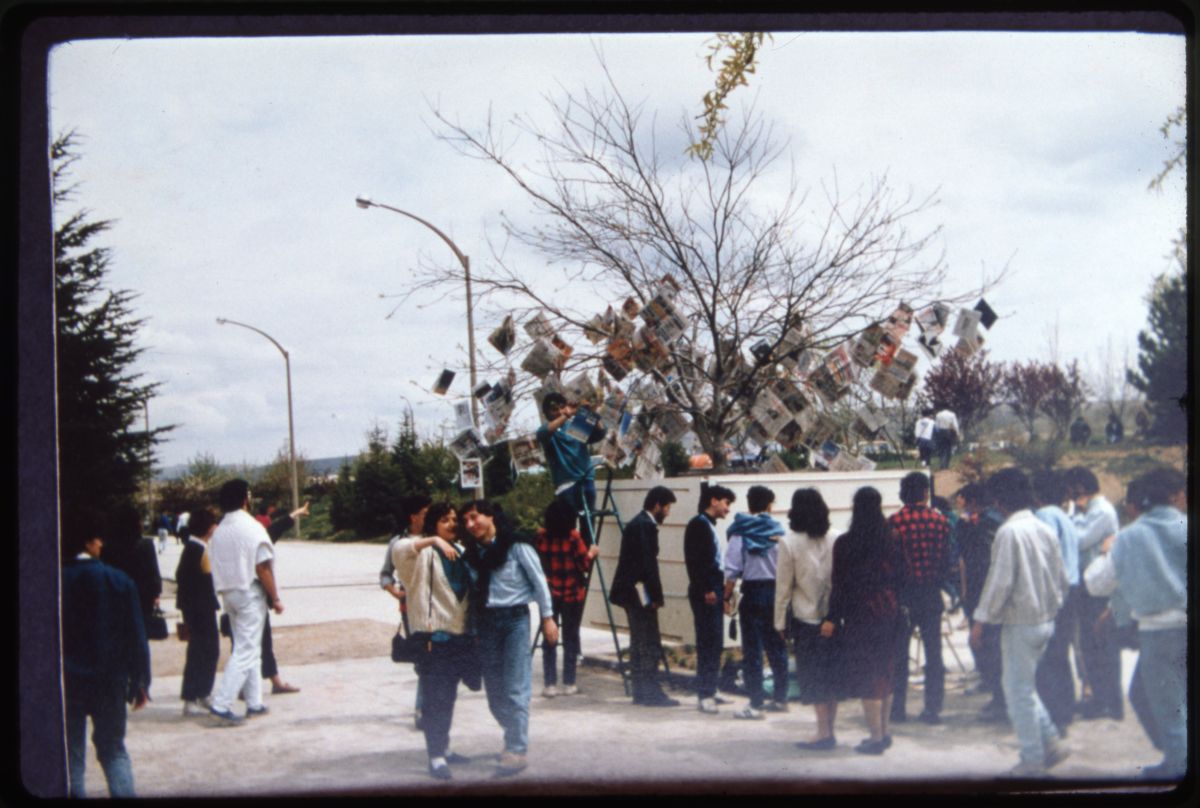
Moni indicates that he encountered the works of many international artists through the libraries of the Goethe-Institute and American Cultural Center in Ankara.2 The exhibitions and events held in these venues, and pioneering exhibitions in Istanbul such as Seretonin (1989 and 1992), gave him the impression that art beyond two-dimensional works was possible. As he was questioning these ideas, he responded to the reaction of his teacher at the time, Turan Erol, who proclaimed “Get rid of this trash” referring to the mixed media works that were not traditional paintings, with the work Pislik [Dirt] (1988), exhibited in the hallways of the Faculty of Fine Arts.
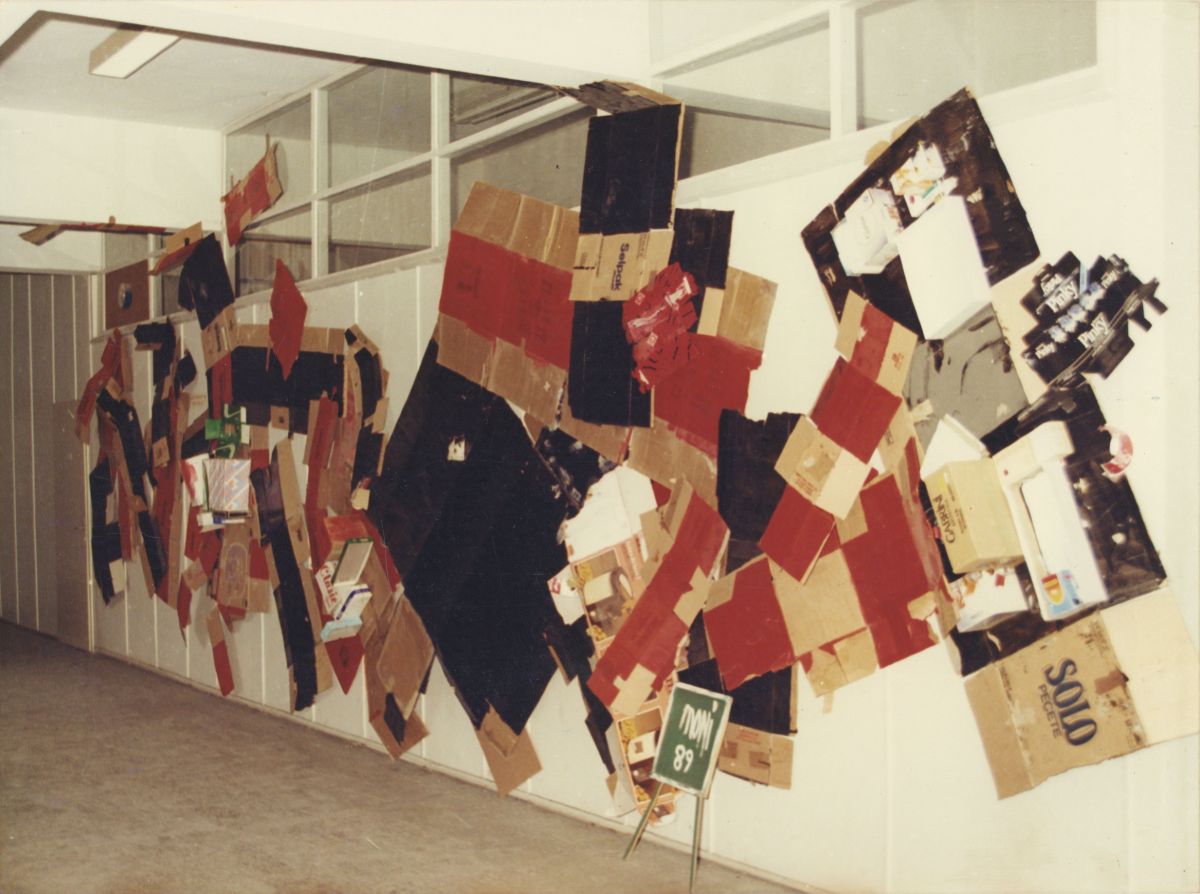
Moni’s interest in the theory and history of art and his tendency to contemplate aesthetic and artistic problems are integrated into his production in different forms ranging from installation to performance. He aims to surprise the audience and to make them think while involving them in the performance of the work. He reinforces his views that art appeals to the whole society and is part of daily life with his works. He develops a proposal for the university campus in Beytepe by including the audience with the colorful windows he presents in his intervention titled Bir Beytepe Düşü [Three Fences in Crows] (1988): “I suggest that this place where we study and live be painted with the most heartwarming and striking colors. I suggest that all houses, private and state-owned, should increasingly be transformed into structures with the most daring designs, distinguishing the power of color and form as much as function.”3
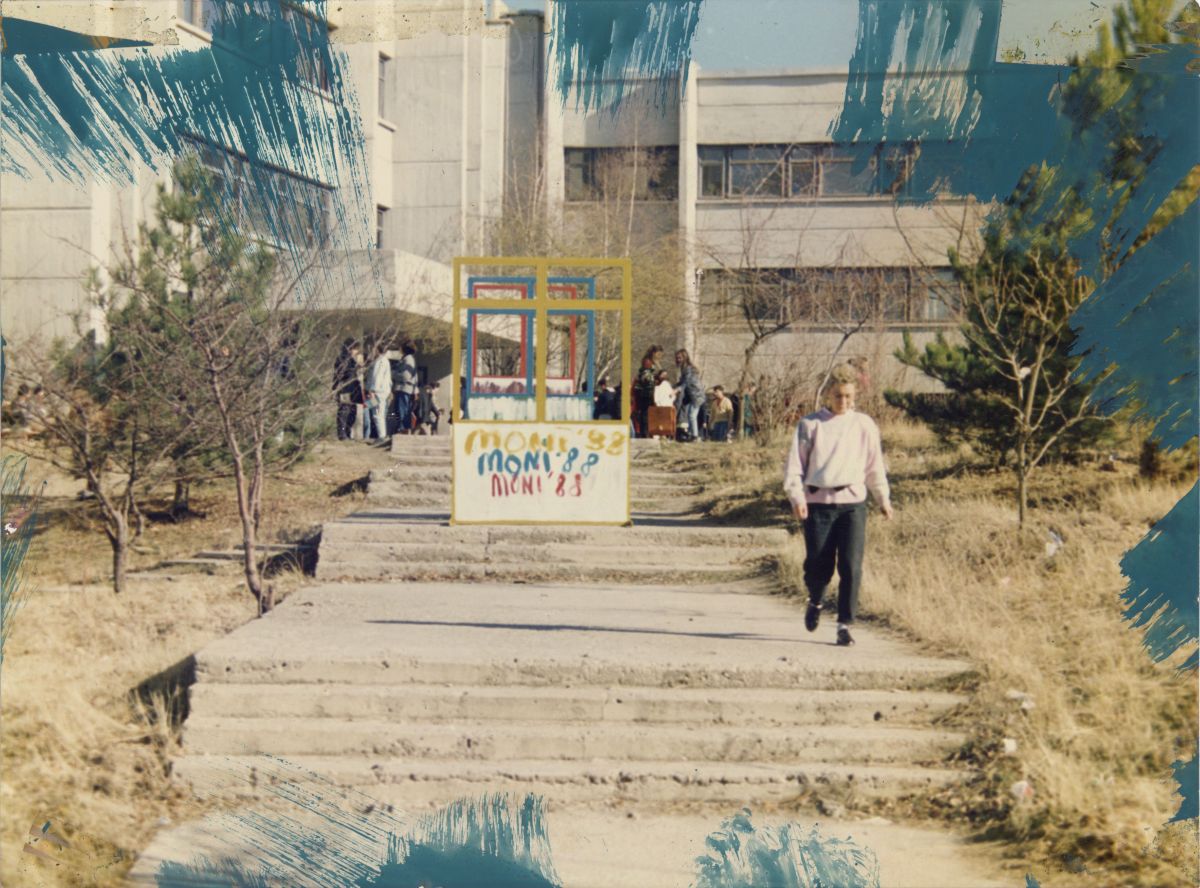
The street is one of the most critical elements in Moni’s works. “They close exhibition halls to me as I want to transform those spaces into the street. If I were to make lovely paintings, they would let me exhibit them. I’m not a bad painter, after all,”4 he articulates when his official applications to spaces were mostly rejected5 and his concern with being stuck between walls would lead him into the street, where he used the streets as space. In one of these works, Sakarya Destanı [The Legend of Sakarya] (1988), the artist laid out his canvas across Sakarya Avenue in Ankara and warned the viewers “that is not a painting”6 to then include the viewers. The work became an improvised action in which he traced the contours of the shadows of those who gathered that fell onto the canvas, coloring them. The 20-30 meter canvas from this action was presented in the exhibition Mutadis Mutandis (1989). Realized in the Celal Bayar (Train Station) Underpass, this exhibition hosted the happening Ölümü Düşünmeden Ölüyü Düşlemek [Not Thinking of Death] (1989), which also demanded the audience’s participation. The artist, influenced by Christo’s “wrapping” action7, invited the participants to wrap themselves up in white cloths, transforming the work into a ritual of confronting death.

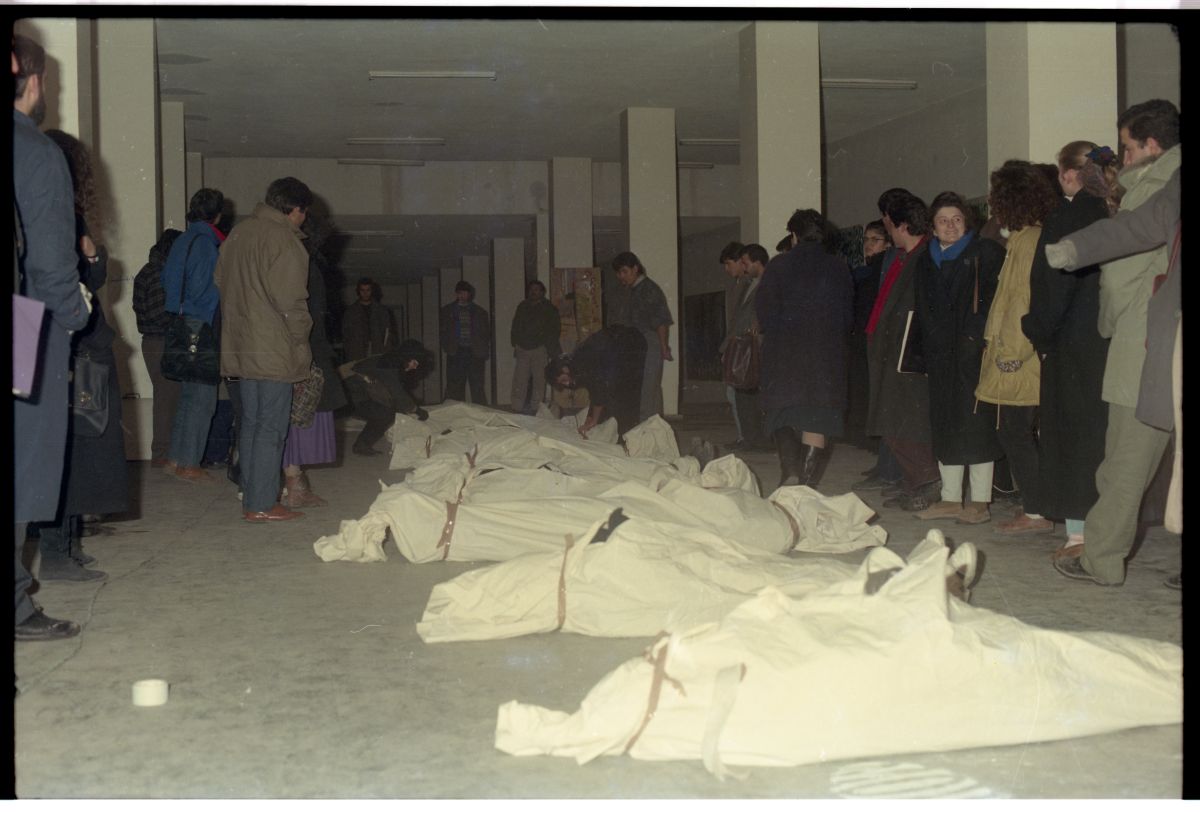
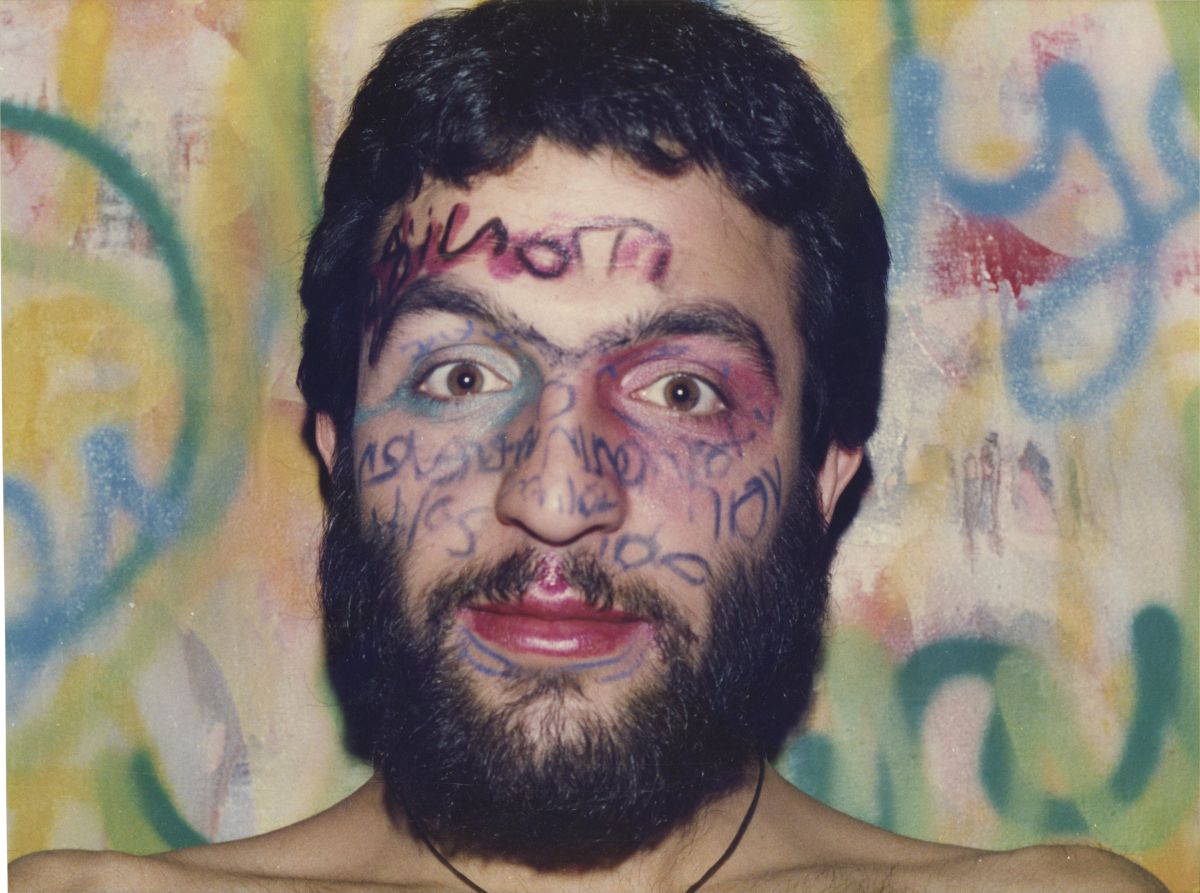
In Sakalın Hikâyesi [The Story of a Beard] (1989), the artist transforms the quotidian act of shaving into a performance and photographs himself. In contrast to the works he performs with the participation of the viewers, he presents this performance through documentation. Next year, he realizes a performance, Eller Eller [Hands Hands] (1990), in which he wrapped the sculpture Eller [Hands] in the Abdi İpekçi Park (Ankara) with gauze. This performance was featured in the newspapers with headlines such as “The Street Painter ‘MONI’s Custody Exhibition,” “This Is Not Hyde Park,” and “Art That Concludes at the Police Station.”8 Tuna Atabinici accompanied the artist on a saxophone, and on a table was a catalog of images and texts on the artist’s works titled Moni ‘89; the performance was interrupted as they were taken to the police station for questioning. The artist was left under suspicion because of using a pseudonym that included the past family name Moni in addition to “Salim Özgilik” before they were both released.
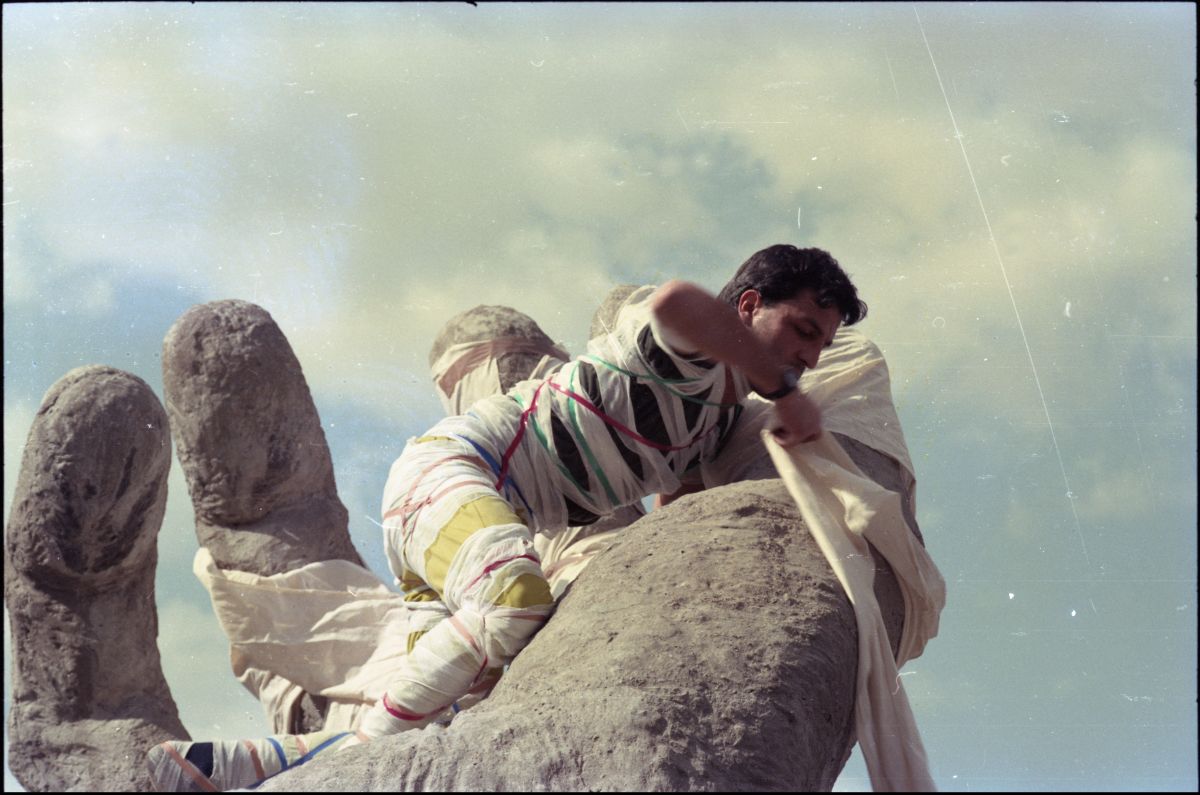
The moment of encounter with the material plays a critical role in the unfolding of Moni’s work. The old fire equipment that the artist came across in the warehouse of the Ankara Metropolitan Municipality inspired him to realize 21. Yüzyıldaki Olası Bir Yangını Söndürme Önerisi [Proposal to Extinguish a Possible Fire in the 21st Century] (1990). He developed a theatrical fire extinguishing proposal for the Botanical Park, which appeared on the barren land of the rapidly urbanizing capital, in Atakule, one of the landmarks of the city.

Moni held two consecutive exhibitions, Party and BüxYü (1990), at the Töbank Art Gallery in Ankara and Istanbul while consistently producing three-dimensional installations, performances, and happenings presented on the street and in public spaces. He prioritizes influencing the audience and integrating with the space in his works and makes arrangements specific to these spaces with the materials he has collected in his studio. Expressing that being in a gallery is no different from a street, the artist considers these arrangements as a process that comes together temporarily, just like performances, for the duration of the exhibition and disposes of the works.9
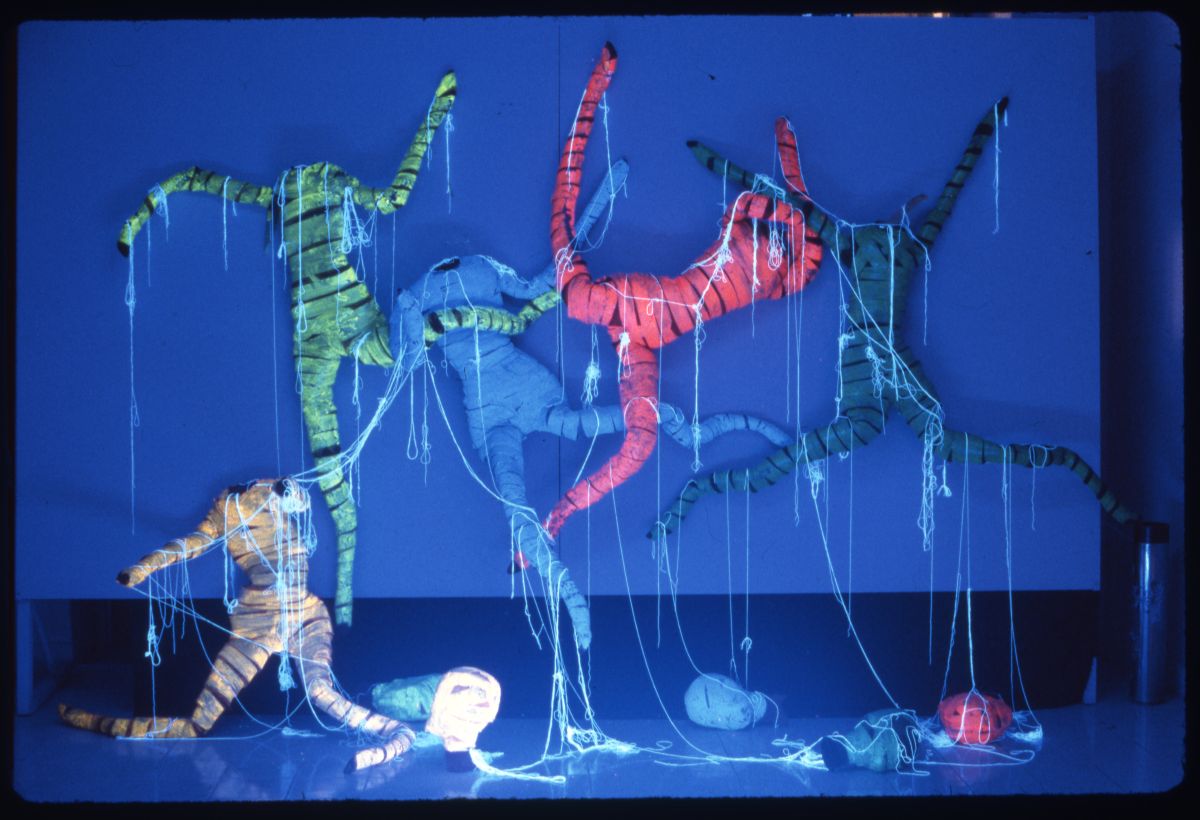
After these exhibitions at the Töbank Art Gallery, Moni went to serve in the military and moved to New York in 1992. There, he continues to produce works, installations, and oil paintings with found materials. Holding a master’s degree in museum studies, the artist maintains his stance focused not only on the performance of art but also on learning, understanding, and questioning art history and theory—a sensibility that he has sustained since his Hacettepe years. He strengthens this with his work Bedrettin Cömert’e İthaf [Homage to Bedrettin Cömert] (1995-1996), produced in response to Western-centered art historiography. He continues to make performances and happenings in New York.
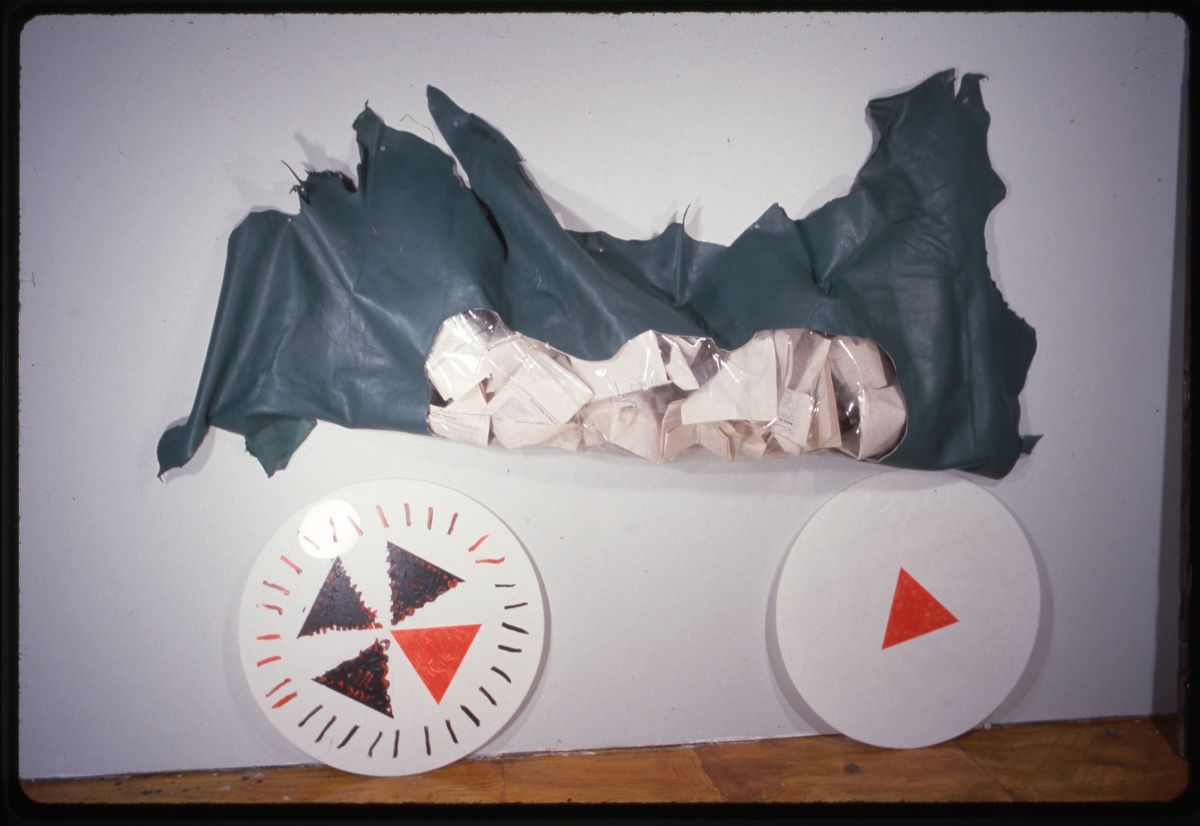
*This text is originally published in Turkish and translated by Merve Ünsal.
- - -
Sezin Romi is the Senior Librarian and Archivist at Salt, where she takes part in various research and archival projects focusing on the history of art in Turkey. She is the editor of the e-publications O zamanlar konuşuyorduk [It was a time of conversation] (2013), Mütevazı Bir Miras - Nilgün Özayten Kitabı [A Modest Heritage - The Book of Nilgün Özayten] (2013), and İpek Duben Yazı ve Söyleşileri 1978-2010 [İpek Duben Texts and Interviews 1978-2010] (2016), among others, and co-editor of İsmail Saray (Salt, 2018), Sentez ve Montaj: Özer Kabaş Yazıları [Montage or Synthesis: Texts of Özer Kabaş] (Salt, 2022), and Stories and Threads: Perspectives on Art Archives (L’Internationale Online, 2022).
Performance and happening became a common form of expression in the second half of the 1980s in Turkey, especially among young artists. One of the pioneers of these emerging trends in Ankara, Moni produced provocative works that overflowed into public spaces and demanded participation. He quit the Geology Engineering Department at Hacettepe University in 1985 and continued his training in the Painting Department of the same university. Hacettepe University’s campus in Beytepe became a center for his production during his years as a student, from 1986 to 1990. The campus, which inspired numerous works by the artist, hosted murals, interventions, and installations that he made with found objects.

Daha Dün Annemizin [Twinkle Twinkle Little Star], Hacettepe University, Ankara, 1988
Salt Research, Moni Salim Özgilik Archive
Salt Research, Moni Salim Özgilik Archive
In his autobiography1, the artist notes that he had begun to focus on “discarded objects, thoughts on the side, concepts that remain in the books.” In his installation Kaos [Chaos] from 1987, presented on the roof of a building, he brought together discarded materials such as egg cartons and disposable cups. The next year, he produced Atık Direnç [Wasted Resistance] (1988) by constructing cardboard box walls, obstacles, and passages, including passersby with this intervention accompanied by music.

Kaos [Chaos], Hacettepe University, Ankara, 1987
Salt Research, Moni Salim Özgilik Archive
Salt Research, Moni Salim Özgilik Archive

Atık Direnç [Wasted Resistance], Hacettepe University, Ankara, 1988
Salt Research, Moni Salim Özgilik Archive
Salt Research, Moni Salim Özgilik Archive
The 1980 coup d’état still influenced social and political life as the self-censorship of the press was ongoing, while the artist was studying at Hacettepe. Moni presented the work Kültür Ağacı [Cultivated Tree] (1988) as a reaction to art news not finding a place in the press. He used found materials as he did in the works Kaos [Chaos] and Atık Direnç [Wasted Resistance], hanging daily newspapers and magazines on a tree to produce a kiosk to draw the attention of passersby.

Kültür Ağacı [Cultivated Tree], Ankara, 1988
Salt Research, Moni Salim Özgilik Archive
Salt Research, Moni Salim Özgilik Archive
Moni indicates that he encountered the works of many international artists through the libraries of the Goethe-Institute and American Cultural Center in Ankara.2 The exhibitions and events held in these venues, and pioneering exhibitions in Istanbul such as Seretonin (1989 and 1992), gave him the impression that art beyond two-dimensional works was possible. As he was questioning these ideas, he responded to the reaction of his teacher at the time, Turan Erol, who proclaimed “Get rid of this trash” referring to the mixed media works that were not traditional paintings, with the work Pislik [Dirt] (1988), exhibited in the hallways of the Faculty of Fine Arts.

Pislik [Dirt], Hacettepe University, Ankara, 1988
Salt Research, Moni Salim Özgilik Archive
Salt Research, Moni Salim Özgilik Archive
Moni’s interest in the theory and history of art and his tendency to contemplate aesthetic and artistic problems are integrated into his production in different forms ranging from installation to performance. He aims to surprise the audience and to make them think while involving them in the performance of the work. He reinforces his views that art appeals to the whole society and is part of daily life with his works. He develops a proposal for the university campus in Beytepe by including the audience with the colorful windows he presents in his intervention titled Bir Beytepe Düşü [Three Fences in Crows] (1988): “I suggest that this place where we study and live be painted with the most heartwarming and striking colors. I suggest that all houses, private and state-owned, should increasingly be transformed into structures with the most daring designs, distinguishing the power of color and form as much as function.”3

Bir Beytepe Düşü [Three Fences in Crows], Hacettepe University, Ankara, 1988
Salt Research, Moni Salim Özgilik Archive
Salt Research, Moni Salim Özgilik Archive
The street is one of the most critical elements in Moni’s works. “They close exhibition halls to me as I want to transform those spaces into the street. If I were to make lovely paintings, they would let me exhibit them. I’m not a bad painter, after all,”4 he articulates when his official applications to spaces were mostly rejected5 and his concern with being stuck between walls would lead him into the street, where he used the streets as space. In one of these works, Sakarya Destanı [The Legend of Sakarya] (1988), the artist laid out his canvas across Sakarya Avenue in Ankara and warned the viewers “that is not a painting”6 to then include the viewers. The work became an improvised action in which he traced the contours of the shadows of those who gathered that fell onto the canvas, coloring them. The 20-30 meter canvas from this action was presented in the exhibition Mutadis Mutandis (1989). Realized in the Celal Bayar (Train Station) Underpass, this exhibition hosted the happening Ölümü Düşünmeden Ölüyü Düşlemek [Not Thinking of Death] (1989), which also demanded the audience’s participation. The artist, influenced by Christo’s “wrapping” action7, invited the participants to wrap themselves up in white cloths, transforming the work into a ritual of confronting death.

Sakarya Destanı [The Legend of Sakarya], Ankara, 1988
Salt Research, Moni Salim Özgilik Archive
Salt Research, Moni Salim Özgilik Archive

Ölümü Düşünmeden Ölüyü Düşlemek [Not Thinking of Death], installation view from the exhibition Mutadis Mutandis, Celal Bayar (Train Station) Underpass, Ankara, 1989
Salt Research, Moni Salim Özgilik Archive
Salt Research, Moni Salim Özgilik Archive

Sakalın Hikâyesi [The Story of a Beard], 1989
Salt Research, Moni Salim Özgilik Archive
Salt Research, Moni Salim Özgilik Archive
In Sakalın Hikâyesi [The Story of a Beard] (1989), the artist transforms the quotidian act of shaving into a performance and photographs himself. In contrast to the works he performs with the participation of the viewers, he presents this performance through documentation. Next year, he realizes a performance, Eller Eller [Hands Hands] (1990), in which he wrapped the sculpture Eller [Hands] in the Abdi İpekçi Park (Ankara) with gauze. This performance was featured in the newspapers with headlines such as “The Street Painter ‘MONI’s Custody Exhibition,” “This Is Not Hyde Park,” and “Art That Concludes at the Police Station.”8 Tuna Atabinici accompanied the artist on a saxophone, and on a table was a catalog of images and texts on the artist’s works titled Moni ‘89; the performance was interrupted as they were taken to the police station for questioning. The artist was left under suspicion because of using a pseudonym that included the past family name Moni in addition to “Salim Özgilik” before they were both released.

Eller Eller [Hands Hands], Abdi İpekçi Park, Ankara, 1990
Salt Research, Moni Salim Özgilik Archive
Salt Research, Moni Salim Özgilik Archive
The moment of encounter with the material plays a critical role in the unfolding of Moni’s work. The old fire equipment that the artist came across in the warehouse of the Ankara Metropolitan Municipality inspired him to realize 21. Yüzyıldaki Olası Bir Yangını Söndürme Önerisi [Proposal to Extinguish a Possible Fire in the 21st Century] (1990). He developed a theatrical fire extinguishing proposal for the Botanical Park, which appeared on the barren land of the rapidly urbanizing capital, in Atakule, one of the landmarks of the city.

21. Yüzyıldaki Olası Bir Yangını Söndürme Önerisi [Proposal to Extinguish a Possible Fire in the 21st Century], Ankara Botanical Park, Atakule, 1990
Salt Research, Moni Salim Özgilik Archive
Salt Research, Moni Salim Özgilik Archive
Moni held two consecutive exhibitions, Party and BüxYü (1990), at the Töbank Art Gallery in Ankara and Istanbul while consistently producing three-dimensional installations, performances, and happenings presented on the street and in public spaces. He prioritizes influencing the audience and integrating with the space in his works and makes arrangements specific to these spaces with the materials he has collected in his studio. Expressing that being in a gallery is no different from a street, the artist considers these arrangements as a process that comes together temporarily, just like performances, for the duration of the exhibition and disposes of the works.9

Installation view from the exhibition BüxYü, Töbank Art Gallery, Istanbul, 1990
Salt Research, Moni Salim Özgilik Archive
Salt Research, Moni Salim Özgilik Archive
After these exhibitions at the Töbank Art Gallery, Moni went to serve in the military and moved to New York in 1992. There, he continues to produce works, installations, and oil paintings with found materials. Holding a master’s degree in museum studies, the artist maintains his stance focused not only on the performance of art but also on learning, understanding, and questioning art history and theory—a sensibility that he has sustained since his Hacettepe years. He strengthens this with his work Bedrettin Cömert’e İthaf [Homage to Bedrettin Cömert] (1995-1996), produced in response to Western-centered art historiography. He continues to make performances and happenings in New York.

Bedrettin Cömert’e İthaf [Homage to Bedrettin Cömert], Brooklyn, New York, 1995-1996
Salt Research, Moni Salim Özgilik Archive
Salt Research, Moni Salim Özgilik Archive
*This text is originally published in Turkish and translated by Merve Ünsal.
Sezin Romi is the Senior Librarian and Archivist at Salt, where she takes part in various research and archival projects focusing on the history of art in Turkey. She is the editor of the e-publications O zamanlar konuşuyorduk [It was a time of conversation] (2013), Mütevazı Bir Miras - Nilgün Özayten Kitabı [A Modest Heritage - The Book of Nilgün Özayten] (2013), and İpek Duben Yazı ve Söyleşileri 1978-2010 [İpek Duben Texts and Interviews 1978-2010] (2016), among others, and co-editor of İsmail Saray (Salt, 2018), Sentez ve Montaj: Özer Kabaş Yazıları [Montage or Synthesis: Texts of Özer Kabaş] (Salt, 2022), and Stories and Threads: Perspectives on Art Archives (L’Internationale Online, 2022).
- 1.The artist's autobiography included in the catalogue, Moni '89. Salt Research, Moni Salim Özgilik Archive.
- 2.Conversation with the artist at Salt Beyoğlu, January 21, 2023.
- 3.The artist's text on Bir Beytepe Düşü (Three Fences in Crows), December 1, 1988. Salt Research, Moni Salim Özgilik Archive.
- 4.Asuman Suner, "Moni 89", Sokak, December 10, 1989. Salt Research, Moni Salim Özgilik Archive.
- 5.The artist's autobiography from the catalog Moni '89.
- 6.Moni '89 catalogue.
- 7.Christo ve Jeanne-Claude, The Pont Neuf Wrapped, Paris, 1985. Photographs from the installation of the work can be accessed via Mustafa Altıntaş Archive at Salt Research.
- 8.For related news, see: Cengiz Özkan, "'Burası Hyde Park Değil'" (This Is Not Hyde Park), Sokak, April 1, 1990, pp. 40-41 and Vahit Aras (interview with the artist), "Karakolda Biten Sanat" (Art That Concludes at the Police Station), Nokta, April 8, 1990, pp. 43-44. Salt Research, Moni Salim Özgilik Archive.
- 9.Oya Ayman Büber, "'Bu İşler Sergiden Sonra Çöpe Atılacak'" (These works will be thrown in the thrash after the exhibition), Güneş Gazetesi, 22 Kasım 1990.

